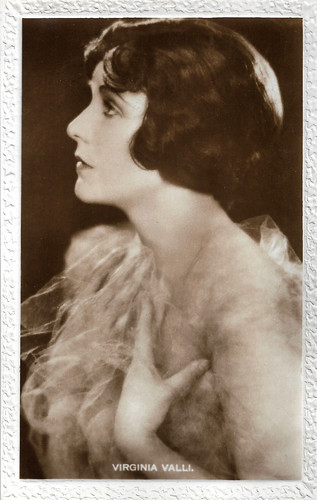
British Real Photograph postcard.
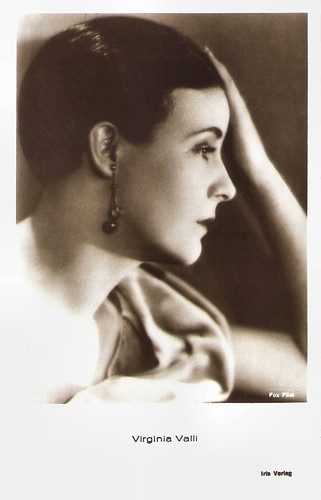
Austrian postcard by Iris Verlag. Photo: Fox Film.

German postcard by Ross Verlag, no. 711/2, 1925-1926. Photo: Unifilman.
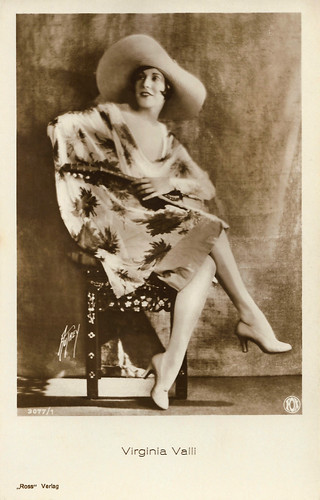
German postcard by Ross Verlag, no. 3077/1, 1928-1929. Photo: Max Munn Autrey / Fox.
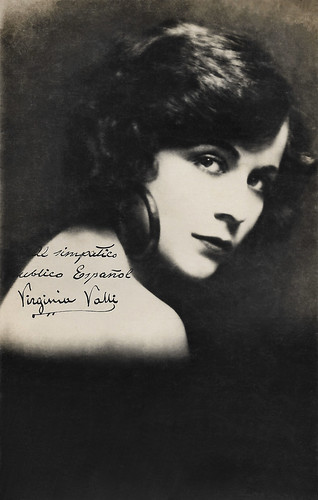
Spanish postcard.
John Ford
Virginia Valli, originally Virginia McSweeney, was born in Chicago, Illinois, in 1895 according to Wikipedia (in 1896 according to IMDb or in 1898 according to AllMovie). She studied dancing and worked as a stenographer before becoming an actress. She started acting in Milwaukee at a theatre stock company.
According to AllMovie, she made her screen debut with the Chicago-based Selig Polyscope Company in 1915. From 1916, she acted in some 18 films at the Essanay Studios in Chicago. There she made her debut in a minor part in the serial The Strange Case of Mary Page (J. Charles Haydon, 1916) with Henry B. Walthall and Edna Mayo, but quickly she played all the female leads of the Essanay productions.
After that, she acted at the studios of World Film, Fort Lee, New Jersey, such as The Black Circle (Frank Reicher, 1919) with Creighton Hale. However, when features came along, Valli was reduced to supporting parts. By 1920, Valli had moved to California to act in films by Fox, Vitagraph and others. By that time she had already adopted the name of Virginia Valli.
A major part she had in the Metro Pictures film The Man Who (Maxwell Karger, 1921) with Bert Lytell and Lucy Cotton, scripted by June Mathis. On the film's success, Metro then put matinee idol Lytell and Valli in a string of popular melodramas, including the boxing drama The Right That Failed (Bayard Veiller, 1922).
In 1922-1924, Virginia Valli did several films for Universal. She had a major part in John Ford's melodrama The Village Blacksmith (1922), based on Henry Wadsworth Longfellow's poem. She also appeared in the Northwoods melodrama The Storm (Reginald Barker, 1922) with House Peters, and in The Shock (Lambert Hillyer, 1923), in which crippled blackmailer Lon Chaney falls in love with the daughter of his banker victim, combined with the San Francisco earthquake.
Other memorable titles were The Signal Tower (Clarence Brown, 1924) with Wallace Beery, Wild Oranges (King Vidor, 1924), The Confidence Man (Victor Heerman, 1924) with Thomas Meighan, and Up the Ladder (Edward Sloman, 1925) with Margaret Livingston.

Spanish card by La Novela Semanal Cinematográfica, no. 77.
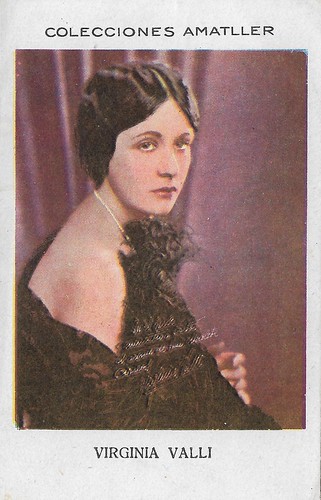
Spanish collectors card by Chocolate Amatller, Series CCC, artist 69, no. 123.

Spanish collectors card in the series Celebridades de la Pantalla y Sus Creaciones, Series A, No. 12. Photo: Distr. Hispano-American Films S.A. / Universal. Virginia Valli in K: the Unknown (Harry A. Pollard, 1924). The man next to her is probably John Roche. The Spanish release title was K el desconocido.
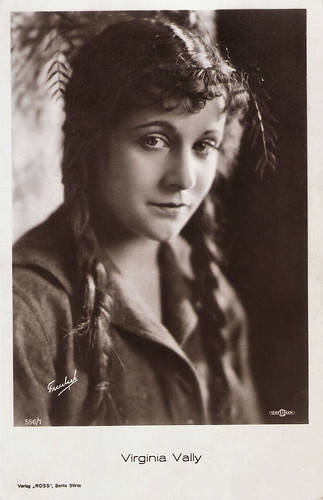
German postcard by Ross Verlag, no. 556/1, 1919-1924. Photo: Roman Freulich / Unfilman.

Italian postcard by G.B. Falci, Milano, no. 126. Photo: Fox Film Corp. Publicity still for Paid to Love (1927) with George O'Brien.

Italian postcard by G.B. Falci, Milano, no. 128. Photo: Fox Film Corp. Virginia Valli in the romantic comedy Paid to Love (Howard Hawks, 1927). Italian title: Il Principe senza amore (The loveless prince).
Alfred Hitchcock
Virginia Valli travelled to Europe to star in the German-British co-production The Pleasure Garden (1925), the first film directed by Alfred Hitchcock when he was 25. Valli was at the height of her career – she was glamorous, famous, and very popular. That a Hollywood star like her was coming to Europe to make a film was an event. Location shooting for The Pleasure Garden was done in Italy and Germany.
The film follows the love lives of two dancers at a London nightspot, called 'Pleasure Garden'. Dancer Patsy Brand (Valli) helps Jill (Carmelita Geraghty) to get a job at the nightspot. Via Jill's fiancee Hugh (John Stuart) she meets Levet (Miles Mander) and eventually marries him. They sail for Italy on a honeymoon. Levett and Hugh then go on a trip to one of the British colonies. Jill, meanwhile, has dropped Hugh for a rich prince who spoils her and she has become distant to Patsy. When Patsy receives notice that her husband is ill, she travels after him but discovers he has an affair with a native woman. Patsy, instead, takes care of a really ill Hugh, which Levet doesn't like...
Hal Erickson at AllMovie: "Filmed on a very tight budget, The Pleasure Garden never betrays its parsimonious nature. And though it cannot be labelled a 'typical' Hitchcock picture, it contains enough clever pictorial touches to indicate that the man in the director's chair was definitely someone to conjure with. To quote the reviewer of the London Daily Express: 'His work is of a uniformly high quality; there are times when it is great, times when the onlooker says to himself 'That is perfect'.' "The Pleasure Garden was produced by Michael Balcon and Erich Pommer. It was Balcon who hired Valli as the star of the film, being one of the first Hollywood stars to come to Europa for filming. Her co-star Carmelita Geraghty was also American.
Virginia Valli continued appearing in Hollywood films throughout the decade. She had no long-lasting contracts with majors, so she played at all major and minor studios in the 1920s. In 1925 Valli acted in the drama The Man Who Found Himself (Alfred E. Green, 1925) with Thomas Meighan. The Famous Players-Lasky production was carried out in the studio of Long Island, New York. Among her later films were also the highlights Stage Madness (Victor Schertzinger, 1927) with Tullio Carminati, the romantic comedy Paid To Love (Howard Hawks, 1927), with George O'Brien and William Powell, and the comedy-drama Evening Clothes (Luther Reed, 1927), with Adolphe Menjou.
Tony Fontana at IMDb: "While she had no trouble adjusting to sound in The Isle of Lost Ships (1929), which she made at First National, her big salary and declining appeal both conspired to end her film career. Unable to find a suitable studio, she would make her last film The Last Zeppelin (1930) at Tiffany Studios." However, her last film was Night Life in Reno (Raymond Cannon, 1931), a low-budget production from small-scale Artclass Pictures. Another view from Hans Wollstein at AllMovie: "Usually considered a victim of sound, Valli actually registered well in her first talkie, Mr. Antonio (1929), and although she was considered a bit stiff and "too English" in The Isle of Lost Ships (1929), her voice recorded well. But no longer in the first bloom of youth by 1930, Valli found herself in a no-win position and chose to retire after Night Life in Reno (1931)".
Virginia Valli had been married from 1921 to 1927 to George Demarest Lamson. In 1931, she wed film actor Charles Farrell, a marriage that lasted until her death. After the wedding, she retired to live in Beverly Hills before moving to Palm Springs. There she had an intense social life for years. For over three decades she ran the popular Palm Springs star hang-out The Raquet Club, which opened on Christmas Day in 1934. Husband Charles Farrell eventually served as mayor of Palm Springs from 1948 until 1954. Virginia Valli suffered a stroke in 1966, and died two years later, in Palm Springs. She was buried in Welwood Murray Cemetery in that city. Valli did not have children.
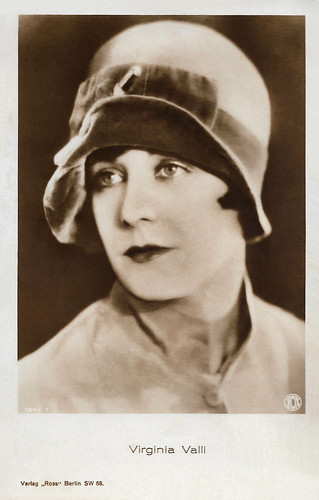
German postcard by Ross Verlag, Berlin, no. 1848/1, 1927-1928. Photo: Fox.

German postcard by Ross Verlag, no. 3843/1, 1928-1929. Photo: Autrey / Fox Film.
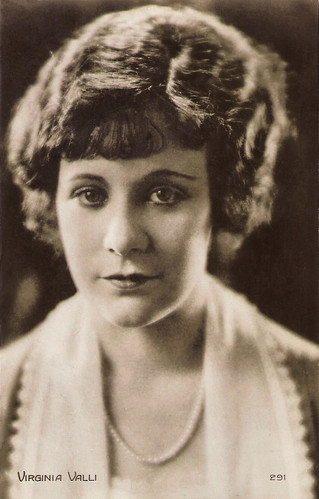
French postcard by Cinémagazine-Edition, Paris, no. 291.
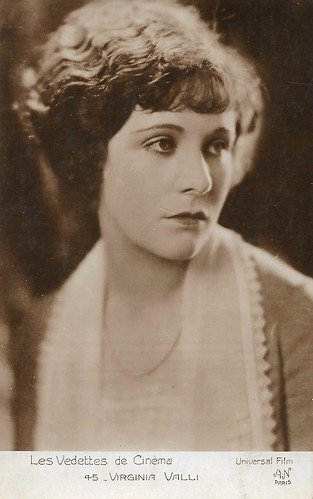
French postcard by A.N., Paris in the Les Vedettes de Cinéma series, no. 45. Photo: Universal Film.

Italian postcard by G.B. Falci, Milano, no. 519a. Photo: Fox Film.

Italian postcard by G. B. Falci Editore, Milano, no. 660. Photo: Fox Film.
Sources: Hal Erickson (AllMovie), Hans J. Wollstein (AllMovie), Tony Fontana (IMDb), Wikipedia (English, Spanish, and Italian) and IMDb.
This post was last updated on 22 October 2022.
No comments:
Post a Comment